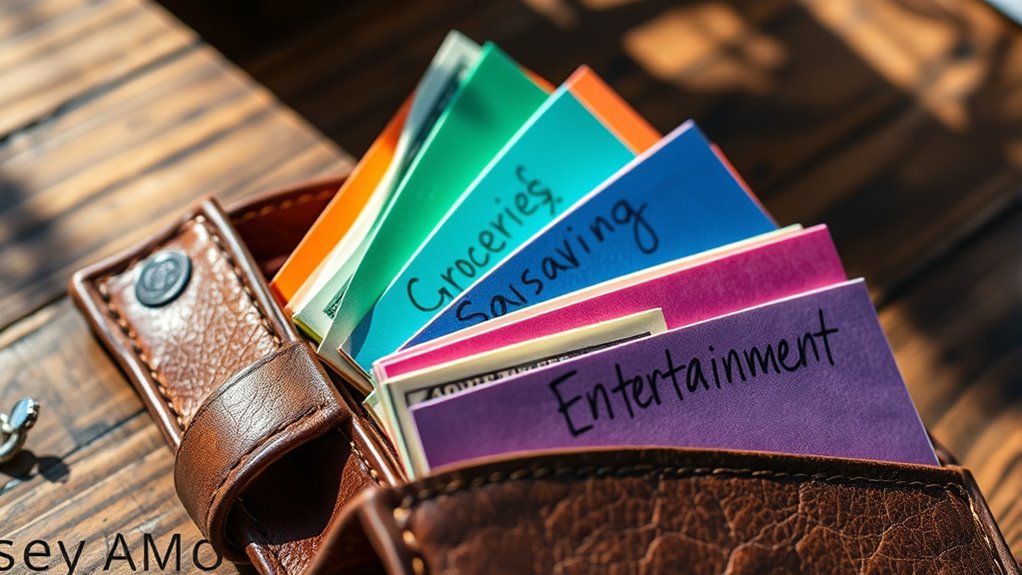Using cash stuffing lets you take control of your money with a simple, old-school approach within your modern budget. By dividing your cash into labeled envelopes for different expenses, you physically see and limit your spending. This method encourages mindful finances, helps avoid overspending, and keeps your goals tangible. If you want to discover how to make this easy system work for you and boost your financial discipline, keep exploring the details below.
Key Takeaways
- Cash stuffing involves dividing cash into labeled envelopes for specific spending or savings categories.
- It promotes mindful spending by making money tangible and limiting expenses once envelopes are empty.
- This old-school method enhances financial discipline and helps achieve savings goals through visual progress.
- It reduces dependence on digital tools, simplifying budget management with physical cash.
- Despite being traditional, cash stuffing effectively encourages control and planning in modern budgeting strategies.

Have you ever wondered how to better control your spending and save more effectively? If so, cash stuffing might be just what you need. This old-school savings method relies on the envelope system, where you allocate physical cash into different envelopes based on your spending categories. By doing this, you create a visual and tangible way to manage your money, making it easier to stick to your budget and avoid overspending. Instead of relying on digital accounts or credit cards, you physically see and handle your money, giving you a clearer picture of how much you have left for each category.
The envelope system works by dividing your income into specific spending categories, such as groceries, entertainment, transportation, and savings. Once you determine your monthly budget for each category, you withdraw the total amount in cash and place it into labeled envelopes. For example, if you decide to allocate $300 for groceries, you put that amount into the grocery envelope. As you spend, you take money directly from the envelope, which helps you stay within your limit. When an envelope is empty, you know you’ve reached your budget for that category, prompting you to cut back or find alternative ways to manage your expenses.
Using cash stuffing simplifies your financial tracking because it’s straightforward and immediate. You don’t need complex apps or spreadsheets to see how much you’ve spent; the physical cash makes it apparent. Plus, it encourages mindful spending since you’re using tangible money rather than digital transfers, which can feel less real. This method also reduces the risk of impulse purchases because you’re limited to the cash in each envelope. Once the money is gone, you’re done for the month in that category unless you decide to reallocate funds intentionally. Incorporating a budgeting approach with cash stuffing can further enhance your financial discipline and planning.
Furthermore, cash stuffing can help you prioritize your financial goals. If saving for a vacation or emergency fund is important, you can create dedicated envelopes for those goals and contribute regularly. It fosters discipline because you have to plan ahead and resist the temptation to dip into other envelopes. Over time, this habit can improve your financial habits appreciably, making you more conscious of your spending and saving patterns.
In today’s digital age, it might seem outdated, but the envelope system remains an effective way to regain control over your money. It’s simple, direct, and helps you develop a healthier relationship with your finances. By incorporating spending categories into your cash stuffing routine, you set clear boundaries for your spending, making your financial goals more attainable and your budget more manageable.
Frequently Asked Questions
How Do I Start Cash Stuffing With a Limited Budget?
Start cash stuffing with a limited budget by focusing on budgeting basics and the envelope system. First, identify your essential categories like groceries, savings, and entertainment. Allocate a small, manageable amount of cash to each envelope weekly. Stick to these limits to avoid overspending. This simple approach helps you stay disciplined, prioritize savings, and gradually build your cash stash, even with a modest budget.
What Are the Best Categories to Prioritize for Savings?
Focus on emergency funds first; they’re your safety net for unexpected expenses. Next, prioritize retirement planning, even with a small amount, to build long-term security. You can also set aside for essential categories like bills or debt. By allocating cash to these priorities, you build a solid foundation that protects you now and prepares you for the future, all while sticking to your limited budget.
How Often Should I Review and Adjust My Cash Envelopes?
You should review and adjust your cash envelopes at least once a month. Don’t worry if your spending varies—regular envelope maintenance helps you stay on track. Conduct a spending review to identify any envelopes needing more or less funds. This way, you stay flexible, make certain your savings goals align with your current needs, and prevent overspending. Consistent checks keep your cash stuffing system efficient and effective.
Can Cash Stuffing Be Combined With Digital Budgeting Methods?
Yes, you can definitely combine cash stuffing with digital budgeting methods. Digital integration allows you to track your envelope balances easily while maintaining the physical cash for envelope customization. This hybrid approach gives you the best of both worlds: the tactile experience of cash stuffing and the organization and insights from digital tools. Just make certain your tracking is consistent so you stay aligned with your financial goals.
What Are Common Mistakes to Avoid When Using Cash Stuffing?
One common mistake is overfunding envelopes, which can lead to cash shortages later. You also neglect tracking, making it hard to see your progress. Did you know 60% of people forget to update their envelopes regularly? To avoid these pitfalls, set realistic amounts and stay disciplined with your tracking. This keeps your cash stuffing effective and prevents overspending or confusion.
Conclusion
So, if you start using cash stuffing, you’ll become a savings superhero overnight! Watch your money multiply faster than rabbits in a carrot patch, and before you know it, you’ll be swimming in cash like a millionaire on a tropical island. Say goodbye to financial stress and hello to total control of your wallet. Trust me, once you try this old-school trick, your savings will explode into something legendary—like a financial superhero in the making!









